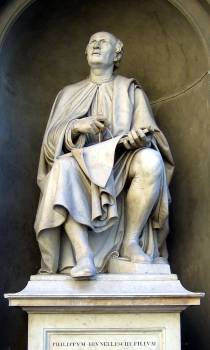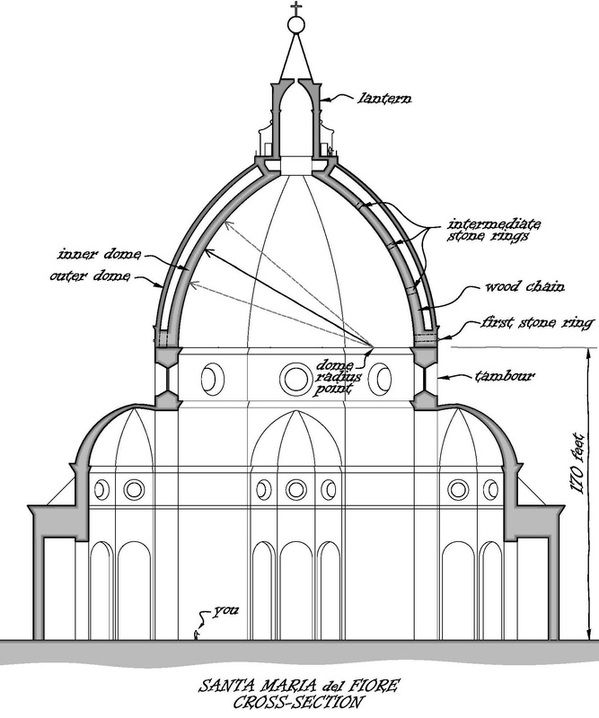Note: Author Ross King was WINNER of Canada’s highest literary award, the Governor General’s Award, for Michelangelo and the Pope’s Ceiling in 2003; WINNER of the Governor General’s Literary Award in 2006 for The Judgment of Paris (about the Impressionist movement); and WINNER of the Governor General’s Award again in 2012 for Leonardo and the Last Supper. He was NOMINATED for this award for Brunelleschi’s Dome in 2000.
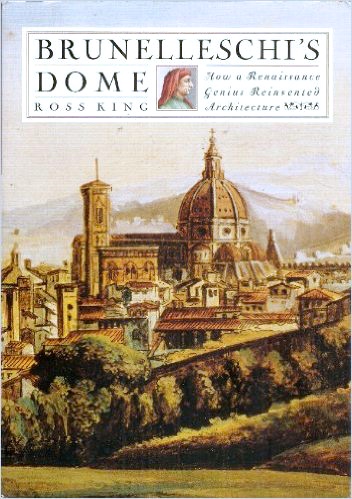 “What man, however hard of heart or jealous, would not praise Pippo the architect when he sees here such an enormous construction towering above the heavens vast enough to cover the entire Tuscan population with its shadow, and done without the aid of beams or elaborate wooden supports?” – Architect/philosopher Leon Battista Alberti, describing the half-built cupola of Santa Maria del Fiore, the Duomo, when he saw it for the first time in 1428, following his return to Florence from exile.
“What man, however hard of heart or jealous, would not praise Pippo the architect when he sees here such an enormous construction towering above the heavens vast enough to cover the entire Tuscan population with its shadow, and done without the aid of beams or elaborate wooden supports?” – Architect/philosopher Leon Battista Alberti, describing the half-built cupola of Santa Maria del Fiore, the Duomo, when he saw it for the first time in 1428, following his return to Florence from exile.
 Author Ross King has, from the beginning of his career, met with huge success for the publication of each of his biographical and cultural narratives about the geniuses responsible for some of the world’s greatest art works: Filippo “Pippo” Brunelleschi, for the dome on the Duomo in Florence; Michelangelo for his work on the Sistine Chapel ceiling; Edouard Manet for his revolutionary Impressionistic style and its contrasts with the style of traditional French classicist Ernest Meissonier; and Leonardo da Vinci for The Last Supper fresco at the Convent of Santa Maria delle Grazie in Milan. Each of King’s books, for all the scrupulous background research, is also filled with the kind of excitement which can only come from the author’s vivid recreation of the agonizing trials and eventual successes of an artist who manages to conquer his own limitations and the doubts of society and/or his patrons, along with the unexpected twists of fate which complicate his life during the creation of a masterpiece. King is an artist in his own writing, clearly understanding what the painter or architect goes through to produce his work, and it is easy for a reader to see parallels and to imagine King living a similar life as he follows his own inspiration to a successful conclusion in his own narrative creations.
Author Ross King has, from the beginning of his career, met with huge success for the publication of each of his biographical and cultural narratives about the geniuses responsible for some of the world’s greatest art works: Filippo “Pippo” Brunelleschi, for the dome on the Duomo in Florence; Michelangelo for his work on the Sistine Chapel ceiling; Edouard Manet for his revolutionary Impressionistic style and its contrasts with the style of traditional French classicist Ernest Meissonier; and Leonardo da Vinci for The Last Supper fresco at the Convent of Santa Maria delle Grazie in Milan. Each of King’s books, for all the scrupulous background research, is also filled with the kind of excitement which can only come from the author’s vivid recreation of the agonizing trials and eventual successes of an artist who manages to conquer his own limitations and the doubts of society and/or his patrons, along with the unexpected twists of fate which complicate his life during the creation of a masterpiece. King is an artist in his own writing, clearly understanding what the painter or architect goes through to produce his work, and it is easy for a reader to see parallels and to imagine King living a similar life as he follows his own inspiration to a successful conclusion in his own narrative creations.
Brunelleschi’s Dome opens with a description of the city of Florence in 1418, when it is holding a competition for artists or architects to produce a model or design for the vaulting of the main dome of the large new cathedral being built there. Six weeks are allowed for the candidate to produce his sample work for the dome, which will complement the cathedral campanile on which the artist Giotto has worked for twenty years. Because of the proportions of the work already completed, the crowning dome will have to be the highest and widest dome ever built – higher and wider than the 143’ diameter of the Pantheon built in Rome a thousand years earlier and never duplicated. The Gothic architecture popular in the rest of Europe, with its flying buttresses to draw the weight of large arches and domes away from the center of the cathedral, does not appeal to the Florentines, who want something different for their cathedral.

Cathedral of Santa Maria del Fiore, the Duomo, in Florence
The finalists in the competition are Filippo Brunelleschi, a goldsmith and clockmaker, and Lorenzo Ghiberti, a worker in bronze who has designed the doors of the Baptistery of Florence. Though they are supposed to share the responsibility for the new dome, Brunelleschi wants complete control and prefers to work in isolation. He has studied Roman ruins, and the surviving Pantheon, and understands the laws of perspective and the use of a vanishing point, so important in surveying and in the creation of domes. He is able to foresee the problems of transporting building materials up hundreds of feet to the dome, then getting them into the exact space required, and he creates unique designs for the machinery he will need, including a hoist with pulleys, wheel bearings, and gears which will allow him to lift an estimated seventy million pounds of marble, brick, stone, and mortar during the construction. He does not see Lorenzo Ghiberti as a partner in this effort, rather as a rival for attention in a project which he alone is directing.
Because the dome will have no central supports, Brunelleschi decides to make it in two parts consisting of eight outer sections in an octagon, with a round dome inside it. Reinforcements will be made in the space between the octagon and the round dome to stabilize the construction and allow workers access to both parts of the dome. Four sandstone chains and many transverse beams will encircle the inner dome invisibly to add to the stability and to protect the construction from wind and weather. Construction seems to be making real progress when complications arise. Brunelleschi, known for tricks played in the past, suddenly becomes very “ill” and must stay at home during one of the most difficult phases of construction. Lorenzo Ghiberti, on his own, is clearly unable to manage or direct the complex construction which is underway, though he is being paid the same salary as Brunelleschi. The city becomes concerned.
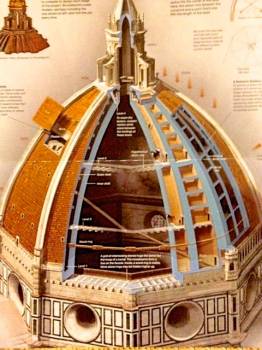
Brunelleschi’s design contained two shells for the dome, an inner shell made of a lightweight material, and an outer shell of heavier wind-resistant materials, solving the problem of weight during construction. Click to enlarge.
When Brunelleschi suddenly “recovers” and returns to work, with a reduction in the role of Ghiberti, new questions are raised about the interior of the dome being “murky and gloomy.” The quality of the mortar for the bricks becomes an issue, and as the interior walls begin to tilt more and more inward as the dome’s construction gets closer to the top, questions of safety for the workers arise. The problems expand. War breaks out against the Duke of Milan, wages are reduced, and the transportation of materials becomes a problem. The Carrara marble needed for the interior becomes difficult to obtain. Work stops for two years. When it finally resumes and the dome itself is largely completed, a competition is then held for the building of the “lantern” for the top of the dome. Once again, all the old jealousies among the builders and architects rage anew.
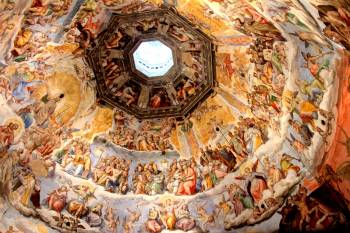
From 1572 – 1579, Giorgio Vassari created a fresco of the Last Judgment on the inside of the cathedral dome. Click to enlarge.
Ross King manages to make the complex engineering and structural feats of building this dome understandable to a lay reader, and while it is still somewhat difficult to imagine Brunelleschi as a real person, he succeeds in making Brunelleschi’s behavior “human” during a time almost totally alien to our own. When the dome is finally finished, twenty-five years after Brunelleschi started it, readers will rejoice at having been able to participate in its construction through reading this novel. In light of the enormous contribution Brunelleschi made to the artistic and architectural history of the world, King’s rendering of Brunelleschi’s death and the recently discovered memorial to him are bittersweet.
ALSO by Ross King: MICHELANGELO AND THE POPE’S CEILING, LEONARDO AND THE LAST SUPPER MAD ENCHANTMENT: Claude Monet and the Painting of the Water Lilies
Photos, in order: The author’s photo appears on http://ourspace.uregina.ca
The sculpture of Brunelleschi looking up at his dome is found on https://en.wikipedia.org/
Santa Maria delle Fiore, the Duomo, is shown on http://www.bhmpics.com/
A drawing of the structure of the dome may be found here: http://archimaps.tumblr.com
Additional drawings of the interior structure of the dome are found on https://sites.google.com/ Brunelleschi’s design contained two shells for the dome, an inner shell made of a lightweight material, and an outer shell of heavier wind-resistant materials. By creating two domes, Brunelleschi solved the problem of weight during construction because workers could sit atop the inner shell to build the outer shell of the dome.
More than a hundred years after the completion of the dome, Giorgio Vasari was hired to paint the Last Judgment as a fresco on its interior. https://sites.google.com/
